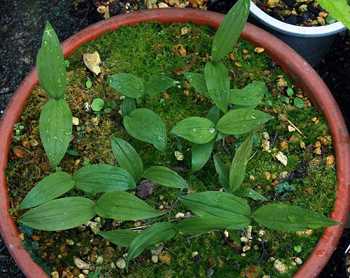grady
Well-Known Member
I am new to Slippertalk, haven't even looked around yet. Over the next few days and weeks I'll read lots and maybe even contribute.
I'm a retired 64-year old man who had little interest in plants (except my forest trees) until about 2007. Since then I've "come alive" to the possibilities of growing, and caring for, flowers, shrubs and trees. My wife and I own 20 acres of land, mostly covered with mature Douglas fir and Ponderosa pine. Canopy closure often exceeds 60%. The forest was last logged in the early 40's; we have many Ponderosa's exceeding 30" diameter. But it's what's growing wild in our forest that has my total attention.
First noticed in about 1999 by my wife, and ignored for years because we didn't know what we had, now there are 13 clumps totaling just over 100 plants of cypripedium montanum, Mountain Lady's Slipper. All of them bloomed and produced seed pods last summer. For the first time, I took photos last summer. One of my photos is now my LS account photo, and a larger version is attached.
What I'm missing is knowledge of what the plant looks like in the years before it flowers. From what I've read, it takes up to 12 years for them to flower. We probably have immature plants here that I don't recognize as such. If anyone can point me to online photos of immature plants I would sure appreciate it.
That's all for now, and thanks for reading!
Grady
I'm a retired 64-year old man who had little interest in plants (except my forest trees) until about 2007. Since then I've "come alive" to the possibilities of growing, and caring for, flowers, shrubs and trees. My wife and I own 20 acres of land, mostly covered with mature Douglas fir and Ponderosa pine. Canopy closure often exceeds 60%. The forest was last logged in the early 40's; we have many Ponderosa's exceeding 30" diameter. But it's what's growing wild in our forest that has my total attention.
First noticed in about 1999 by my wife, and ignored for years because we didn't know what we had, now there are 13 clumps totaling just over 100 plants of cypripedium montanum, Mountain Lady's Slipper. All of them bloomed and produced seed pods last summer. For the first time, I took photos last summer. One of my photos is now my LS account photo, and a larger version is attached.
What I'm missing is knowledge of what the plant looks like in the years before it flowers. From what I've read, it takes up to 12 years for them to flower. We probably have immature plants here that I don't recognize as such. If anyone can point me to online photos of immature plants I would sure appreciate it.
That's all for now, and thanks for reading!
Grady






